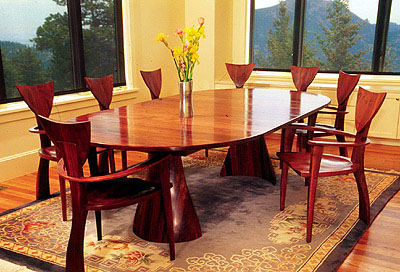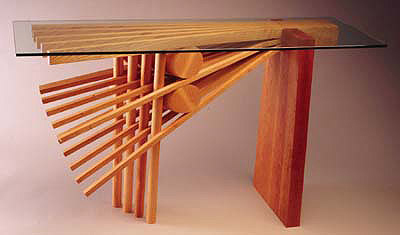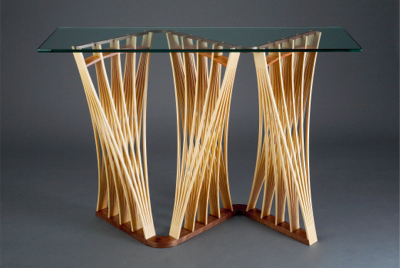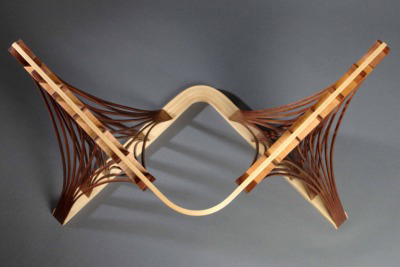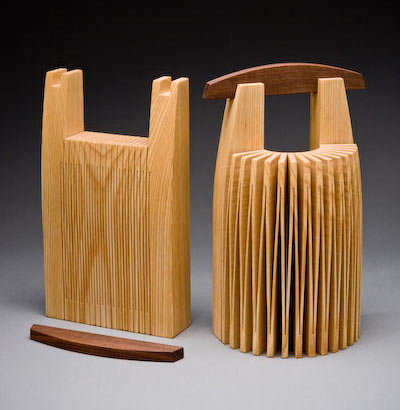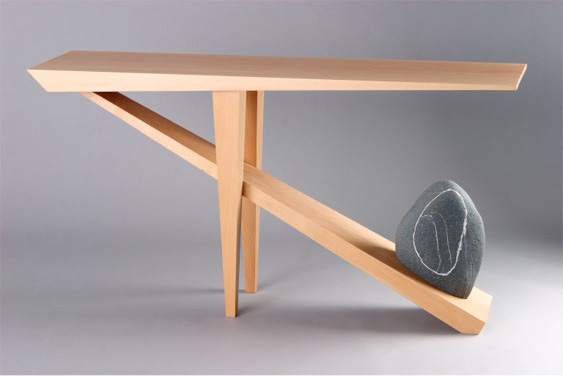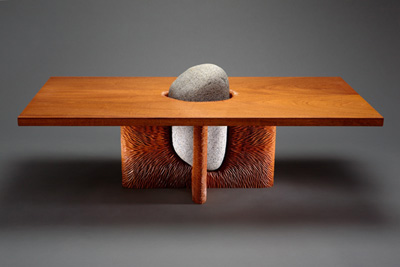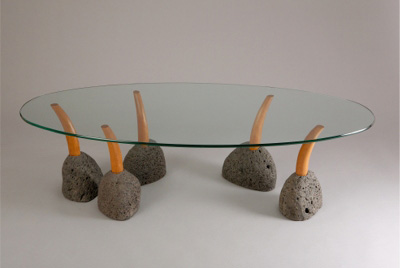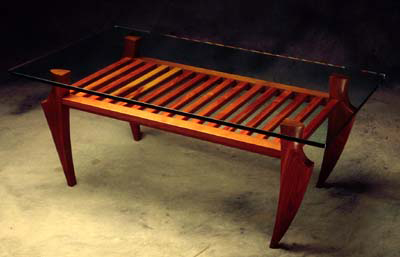
“My mom, who was an architect, taught me to use a hammer when I was pretty young,” Seth Rolland told me when I asked him about his earliest woodworking experiences. “I grew up by the water in Rye, New York, and built a raft at the age of six out of scavenged driftwood and Styrofoam®, but that was about it for woodworking until after college. During my last semester, I was in a program at Mystic Seaport learning to build a small wooden skiff, and after college I went to work for several months as the first mate on a schooner. A schooner,” Seth explained when I admitted my nautical ignorance, “is a sailboat with two masts, the second of which is taller than the first. If the first one is taller, it is called a ketch or a yawl.
“After that, I went to work for a boat builder in Connecticut for about three months, mostly sanding. During my stay there, I met a furniture maker who offered me a job, and I took it. I stayed at that job for six months, saved some money, and went traveling for a year. When I returned, I rebuilt a boat for a client in Maine, then moved to New Mexico to be with the woman I eventually married. This was about 1990, and she was making and selling tie-dyed clothing at craft fairs.
“She suggested I make something to sell in her booth. I bought some tools and wood, made a chair in time for the next weekend’s show, and sold it. Before long, I had my own booth next to hers and was selling patio furniture. I built a 400-square-foot workshop, and started manufacturing in earnest. That went on for the next five years. By the end, I was making simple folding patio furniture in batches of 100 by rigging up jigs and fixtures to allow me to mass produce parts. To a certain degree, I credit my ability to make money as a furniture maker today to the five years I spent mass producing that simple, inexpensive patio furniture.
“During that time, I started taking woodworking classes to learn more sophisticated design and construction methods, and started making more challenging, one-of-a-kind pieces. In 2001, we decided to move closer to the water, and settled in Port Townsend, Washington on the Olympic peninsula. I opened a shop next to our house and have been here since. My wife, after the move, became an EMT and firefighter with the local fire department.
“From about 1992 on, I started expanding into other designs. One of the design rules that resonates with me is that if it does not look good in gray, it is not a good design. I think it is a mistake to depend on the flashiness or the figure of a piece of wood to compensate for a lack of good lines. Figured exotic wood is often used as a crutch for mediocre design. When I think of the pieces by designers I am impressed with, it is not the wood figure but the structure that stands out.
“I see my own design work as falling into three groups. The earliest group mirrored a lot of curved forms from nature, and is concerned with how pieces interact with the ground. Some, like the King Crab and Sunburst tables, appear to touch lightly, while others, like the Tinsman table, are very firmly rooted with larger, heavier feet.
“After I made the Sunburst table, which was created by cutting big boards into 125 tapered pieces and gluing them back together, I started to wonder if I could make a piece of furniture by cutting pieces only partway through. If I did not cut them all the way apart, I reasoned, I would not have to glue them back together. The result was a series of expanded wood pieces. The top of Ash Explosion 1 starts with a four by six ash beam cut partway through and steam bent open. That element continues through my work, such as Ash Explosion 2, a coffee table. In it, the split and expanded wood explodes out of a stone slab that forms the main vertical member.
“The parabola tables take that idea a step further with cuts from both directions. Each of the two walnut supports of the Parabola Side Table is one continuous piece of wood carefully cut from several directions. I then heat them with steam and quickly bend and expand them to their final shape before they cool. After they dry, they hold their new shapes, and are stiffened with the continuous pieces of laminated ash and cherry.
“The Dreamcatcher Hall Table is my most ambitious effort in that direction. All of the ash structure started as one 36-inch long piece of wood, five-and-a-half inches wide and two-and-a-half inches thick. Like an accordion, it has been expanded in both directions to form a table base over 40 inches by 12 inches. The bottom and top were then stabilized with the mahogany pieces, creating an extremely strong table.
“To make cutting and expanding work, I start with straight grained North American hardwood that is air dried to 25 percent moisture content, make the various cuts, then steam and bend it. After that, it goes into a form to hold its shape, and sits for several weeks to dry down to eight percent or 10 percent moisture content.
“Another iteration of the same idea came from my desire to use up scrap wood. The Stonehenge Book Ends, cut and opened into a half circle like an accordion, are a good example employing the same sort of idea. The room divider, which is also cut and expanded, incorporates actual leaf skeletons, the veins of leaves after the web is gone, embedded in clear resin. It is designed to be beautiful from both sides and to be translucent enough to let light pass through. Like frosted glass, it does not obscure the wood just behind it but does obscure anything more than a foot behind it.
“My most recent work incorporates stones, sometimes large ones, to allow me to build with elaborate cantilevers. The stones act as a counterbalance. I like mixing materials, but I did not want to simply plunk a pretty piece of stone in the middle. I wanted it to be functional. With some, like the North Beach table, it is obvious how the stone acts as a counterweight. Others are less obvious. On the Tsubo table, the stone allows for a larger top-to-base ratio without tipping under weight. The stones on the Sprout tables allows as many legs as you want, each freestanding from the others, configured in a variety of options.”
With such a wealth of creative ideas, it is no surprise that Seth values designing more than copying. “A lot of people think you get more from copying historical pieces,” he admitted, “but I think you learn more by attempting your own designs. Its more fun, and you learn more about self-expression to boot. I often find in the classes I teach that those who have the most experience as woodworkers sometimes have the most difficult time, or are most fearful of, coming up with their own designs and finding their own esthetic.”
Obviously, that’s not a problem for Seth Rolland.
